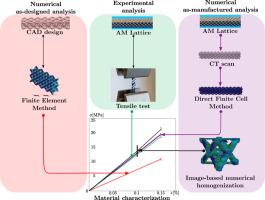Additive Manufacturing ( IF 10.3 ) Pub Date : 2021-03-20 , DOI: 10.1016/j.addma.2021.101949 N. Korshunova , G. Alaimo , S.B. Hosseini , M. Carraturo , A. Reali , J. Niiranen , F. Auricchio , E. Rank , S. Kollmannsberger

|
The production of lightweight metal lattice structures has received much attention due to the recent developments in additive manufacturing (AM). The design flexibility comes, however, with the complexity of the underlying physics. In fact, metal additive manufacturing introduces process-induced geometrical defects that mainly result in deviations of the effective geometry from the nominal one. This change in the final printed shape is the primary cause of the gap between the as-designed and as-manufactured mechanical behavior of AM products. Thus, the possibility to incorporate the precise manufactured geometries into the computational analysis is crucial for the quality and performance assessment of the final parts. Computed tomography (CT) is an accurate method for the acquisition of the manufactured shape. However, it is often not feasible to integrate the CT-based geometrical information into the traditional computational analysis due to the complexity of the meshing procedure for such high-resolution geometrical models and the prohibitive numerical costs. In this work, an embedded numerical framework is applied to efficiently simulate and compare the mechanical behavior of as-designed to as-manufactured octet-truss lattice structures. The parts are produced using laser powder bed fusion (LPBF). Employing an immersed boundary method, namely the Finite Cell Method (FCM), we perform direct numerical simulations (DNS) and first-order numerical homogenization analysis of a tensile test for a 3D printed octet-truss structure. Numerical results based on CT scan (as-manufactured geometry) show an excellent agreement with experimental measurements, whereas both DNS and first-order numerical homogenization performed directly on the 3D virtual model (as-designed geometry) of the structure show a significant deviation from experimental data.
中文翻译:

基于图像的八度桁架晶格结构抗拉性能的数值表征和实验验证
由于增材制造(AM)的最新发展,轻质金属晶格结构的生产受到了广泛的关注。但是,设计的灵活性来自底层物理的复杂性。实际上,金属增材制造会引入工艺引起的几何缺陷,这些缺陷主要导致有效几何形状与标称几何形状之间的偏差。最终印刷形状的这种变化是导致AM产品的设计力学性能与制造力学性能之间出现差距的主要原因。因此,将精确制造的几何形状合并到计算分析中的可能性对于最终零件的质量和性能评估至关重要。计算机断层扫描(CT)是获取制造形状的准确方法。然而,由于这种高分辨率几何模型的网格划分过程非常复杂,而且成本很高,因此将基于CT的几何信息集成到传统的计算分析中通常是不可行的。在这项工作中,将使用嵌入式数值框架来有效地模拟和比较设计与制造的八度桁架-桁架晶格结构的机械性能。使用激光粉末床熔合(LPBF)生产零件。我们采用沉浸边界方法,即有限元方法(FCM),对3D打印八角形桁架结构进行拉伸试验的直接数值模拟(DNS)和一阶数值均质分析。基于CT扫描(制造的几何形状)的数值结果与实验测量结果非常吻合,











































 京公网安备 11010802027423号
京公网安备 11010802027423号